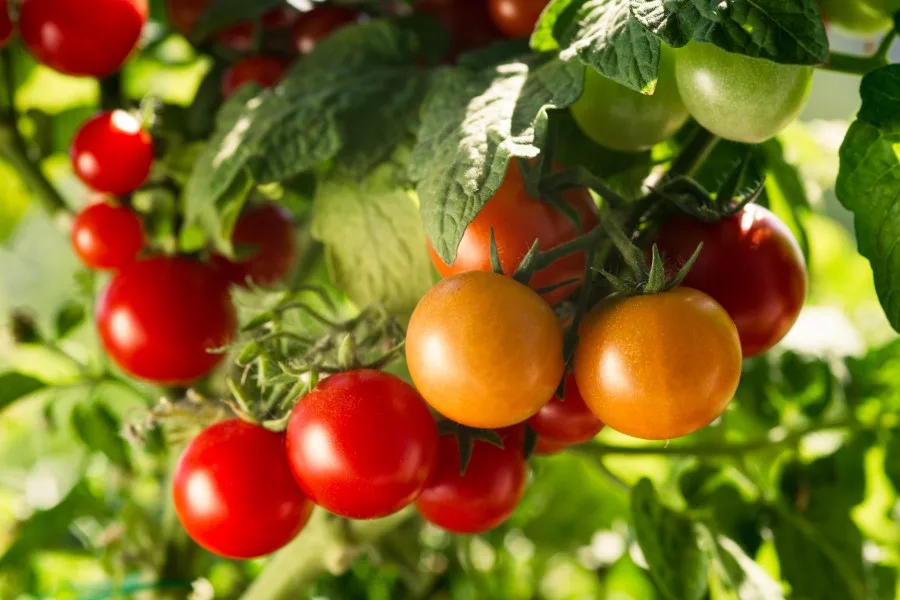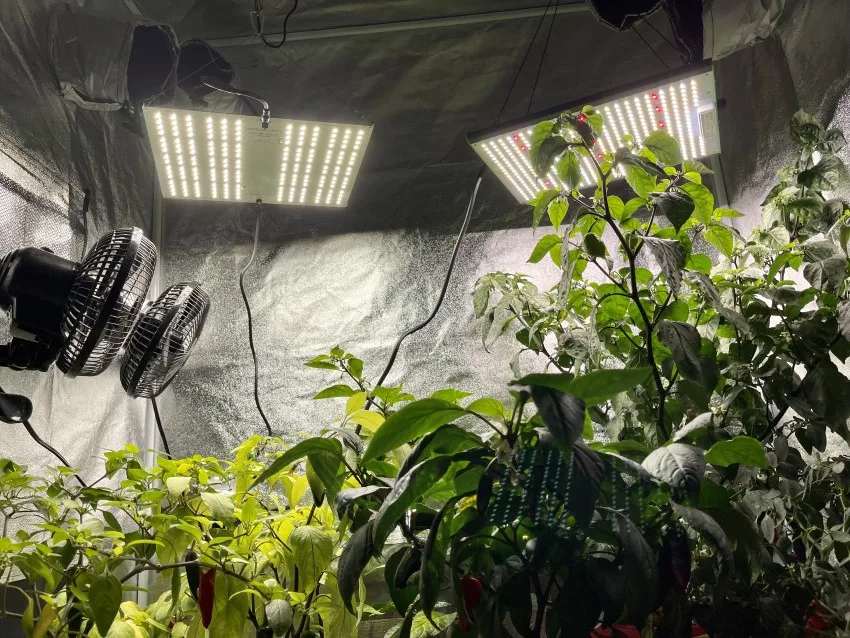If you’re growing tomatoes indoors, it’s important they get enough light. Generally, tomato plants require at least six to eight hours of light per day to bear fruit. There are two popular types of grow lights that you should consider when growing indoor tomato plants to provide them with additional light: LED and HPS lights.
The best grow light for tomatoes is an LED light. They’re cost-effective, enhance your tomato plants’ growth, and prevent them from being exposed to excessively high temperatures.
In this article, we’ll explore what you need to know about choosing the best grow lights for tomatoes and why LED lights have advantages over HPS lights. We’ll also examine why combining LED and HPS lights can also be beneficial.

As an Amazon Associate, I earn from qualifying purchases.
What Type of Grow Light is Best for Tomatoes – HPS or LED?
LED and HPS grow lights are commonly used to grow plants such as tomato plants. Let’s look at both of them and their pros and cons, so you can decide which one is best for your grow tent or greenhouse.
LED Grow Lights
LED lights are a popular type of grow light for tomatoes, and they can be used all year round to grow tomatoes. LED grow lights produce only low amounts of heat which means they have minimal risk of burning shade cloth or other flammable items in your grow tent.
I personally use LED grow lights for my indoor plants and recommend using them instead of HPS due to the lower heat levels alone.
Since LED lights promote tomato growth at lower temperatures, the plants require less water as they’re not at risk of drying out from exposure to high heat.
LED lights are also beneficial from an affordability angle because they can last for 50,000 hours or more, making them an even more economical option than HPS lights if you want to maximize your tomato yield.
LED grow lights are not without drawbacks. These lights can cause what’s known as a light burn on your tomato plants, which can cause the plant’s leaves to turn yellow and white. To reduce the risk, ensure that you place your tomato plants about 12-18 inches (30-45 cms) away from the lights.
LED lights are generally better for tomatoes than HPS lights, even though both have pros and cons. When planted underneath LED grow lights alone, tomato plants typically grow abundantly.
This has been confirmed by science. A study found that the tomato leaves of plants placed under HPS lights grew thinner and aged quicker in winter than tomatoes placed underneath LED grow lights, as Acta Horticulturae reports.
Another important thing to consider when buying grow lights for your tomato plants is how they affect the nutritional content and pigment of the tomatoes. A study found that while there wasn’t any difference in the number of leaves, leaf area, or stems of the plants when they were grown under either HPS and LED lights, some crucial differences occurred in their carotenoid production.
Both lutein and lycopene, which are antioxidants, in the tomatoes were 142% and 18% higher, respectively, when the plants were grown under LED lights instead of HPS lights, as Frontiers in Plant Science reports.
However, when it comes to the B-carotene content of tomatoes, which is its red-orange pigment, both LED and HPS grow lights achieved the same result, as the same study found. They, therefore, ensure that your tomatoes will look bright and beautiful.
HPS Grow Lights
HPS stands for High-Pressure Sodium (HPS). HPS grow light uses concentrated yellow and red lights to encourage tomato fruits and flowers to thrive. What’s especially beneficial about this type of grow light is that tomato plants growing beneath them maintain their energy for reproduction, ensuring they can survive and thrive throughout the growing season.
HPS bulbs shine intensely onto plants, encouraging them to produce more food via photosynthesis, a process through which plants combine light energy with carbon dioxide and water to make sugar glucose. This ingredient is essential for plants to grow healthy.
Since they emit red light, the longest wavelength, HPS grow lights are ideal for fruit plants like tomatoes. The red light will boost the tomato’s stem, fruit, and flower growth.
HPS lights have been used for many years and are one of the most common types of grow lights. They emit up to 10,000 hours of light before needing replacement, so they’re economical. However, there are some significant drawbacks of these lights, which include:
- HPS lights can become very hot, and you should never place shade cloth or other flammable materials close to them.
- Their high heat means you must ensure that your greenhouse or grow tent has enough ventilation for your plants. Luckily, many HPS light fixtures on the market are designed with vents. I have an article on how to reduce grow light heat if you need help with that problem.
Combining LED With HPS Grow Lights
There are benefits of using LED and HPS lights simultaneously. In the same study mentioned in the previous section, tomato plant leaves placed under LED alone or exposed to a blend of LED and HPS lights had greater photosynthesis capacity during the winter compared to leaves grown solely with the aid of HPS lights.
Another study, reported by the Czech Academy of Agricultural Sciences, found that supplementing HPS lighting with LED lights increased early tomato yield compared to using HPS alone. And, both HPS and LED grow lights increased tomatoes’ marketable and total yields.
A hybrid setup of HPS and LED grow lights gives you more control over the temperature of your grow tent than only having HPS lights installed. Bear in mind that your tomatoes will require temperatures of about 70-80°F (21-26°C) during the day and 60-68°F (15-20° C) at night, as Texas A&M AgriLife Extension states.

Which LED Grow Light is Best for Growing Tomatoes?
The best LED grow light for tomatoes is a full-spectrum light. These lights are the most cost-effective and prevent a hot surface temperature that can damage the fruit. They also have fuller light wavelengths, helping to provide a larger tomato yield.
It’s important to ensure that the LED lights you purchase for your grow tent have heat sinks. This draws heat away from the light to prevent too much heat from being targeted at the tomato plants, which can burn or dry them, reducing your yield.
Finally, check the K (Kelvin) value of the light. When growing produce such as tomatoes, you want your lights to mimic natural sunlight as much as possible, so you should aim for a range of approximately 6,000K.
As long as your grow lights offer between 5,000 and 6,500K, this will ensure your plants can remain healthy during all stages of growth.
With the above points in mind, I recommend the Viparspectra Timer Control Series TC600 LED Grow Light for growing tomatoes, which is available from Amazon. It can be used for all plant growth stages and comes with advanced high-speed, quiet fans, and aluminum cooling heat sinks to ensure efficient heat dissipation. It also provides 3,000-7,500K for the different growth stages of your tomatoes.
Which HPS Grow Light is Best for Growing Tomatoes?
When choosing HPS grow lights for tomatoes, and if you want to combine them with LED grow lights, ensure they have temperature control features. This makes it convenient for you to control how much light strikes your tomato plants and prevents the lights from becoming too hot.
My favorite HPS grow light for tomatoes is the Sun System HPS 150 Grow Light, available from Amazon. It provides plants with light that mimics natural sunlight for maximum growth and comes with a powerful 16,000-lumen count.
This HPS grow light comes with vented housing for excellent heat dissipation and provides five times more light per watt when compared to standard incandescent bulbs. Ensure you always keep the HPS lights about five to eight feet (1.5-2.4 meters) away from the tomato plants so that they don’t get too much heat, inhibiting their growth.
A large lumen count is essential when growing tomatoes, but how many you should have depends on the tomato plant’s growth stage. When the plant’s seedlings have broken through the soil, the plant requires approximately 7,000 lumens.
In contrast, when the plant is nearing its flowering stage, it will need around 10,000 lumens so that you mimic the sun on a warm mid-summer day, as Washington State University reports.
Closing Thoughts
If you’re eager to grow tomatoes in a greenhouse or grow tent at home, you will have to choose between two popular grow lights: LED and HPS. As we’ve seen in this article, you can use both to grow healthy and vibrant tomato plants.
While LED lights have some advantages over HPS lights, using them together is also effective. Reasons why you should consider this hybrid setup include:
- It promotes greater photosynthesis capacity.
- It can increase your early tomato yield.
- It enables you to control the plants’ temperature better.
